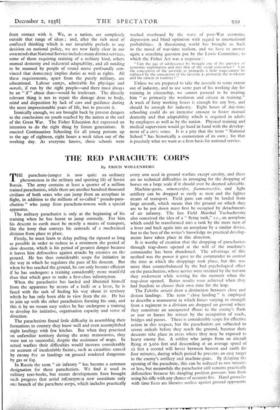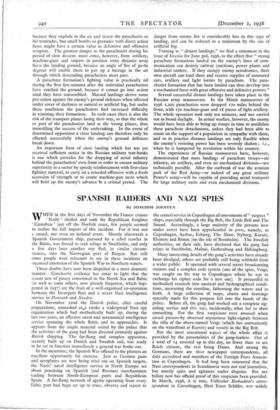THE RED PARACHUTE CORPS
By ERICH WOLLENBERG
THE parachute-jumper is now quite an ordinary phenomenon in the military and sporting life of Soviet Russia. The army contains at least a quarter of a million trained parachutists, while there are another hundred thousand civilians of both sexes who can jump from an aeroplane in flight, in addition to the millions of so-called " pseudo-para- chutists " who jump from parachute-towers with a special apparatus.
The military parachutist is only at the beginning of his training when he has learnt to jump correctly. For him his descent to earth must be merely a means of transport, like the lorry that conveys his comrade of a mechanised division from place to place.
Firstly, he must learn to delay pulling the ripcord as long as possible in order to reduce to a minimum the period of slow descent, which is his period of greatest danger because it leaves him defenceless against attacks by enemies on the ground. He has thus considerable scope for initiative in the way in which he regulates the pace of his descent. But when he has reached the ground, he can only become efficient if he has undergone a training considerably more manifold than that which goes to make a first-class infantryman.
When the parachutist has landed and liberated himself from the apparatus by means of a knife or a lever, he is faced with the task of finding his way about in territory which he has only been able to view from the air. He has to join up with the other parachutists forming his unit, and this is by no means easy unless he has undergone a training to develop his initiative, organisation capacity and sense of direction.
The parachutists found little difficulty in assembling their formations in country they kbew well and even accomplished night landings with few hitches. But when they practised on unfamiliar territory during the army manoeuvres, they were not so successful, despite the assistance of maps. In actual warfare their difficulties would increase considerably on account of incalculable factors, such as casualties caused by enemy fire or landings on ground rendered dangerous by gas or fog.
In Russia the term " air infantry " has become a common designation for these parachutists. We find it used in military text-books, but recent developments have brought such progress that aerial infantrymen now constitute only one branch of the parachute corps, which includes practically every arm used in ground warfare except cavalry, and there are no technical difficulties in arranging for the dropping of horses on a large scale if it should ever be deemed advisable.
Machine-guns, minenwerfer, flammenwerfer, and light artillery can be dropped as easily as men and the lighter means of transport. Field guns can only be landed from large aircraft, which means that the ground on which they are to be put down must first be occupied by detachments of air infantry. The late Field Marshal Tuchachcvsky also conceived the idea of a " flying tank," i.e., an aeroplane which could be transformed into a tank by the mere turn of a lever and back again into an aeroplane by a similar device, but to the best of the writer's knowledge no practical develop- ments have taken place in this direction.
It is worthy of mention that the dropping of parachutists through trap-doors opened at the will of the machine's commander has been abandoned. The advantage of this method was the power it gave to the commander to control the time at which the droppings took place, but this was more than counterbalanced by the bad psychological effect on the parachutists, whose nerves were strained by the tension they underwent while waiting for the moment when the trap-door opened. Better results were achieved when they had freedom to choose their own time for the leap.
The Taktika aviatii draw a distinction between close and distant landings. The term " close landing " is employed to describe a manoeuvre in which forces varying in strength from a regiment to a division are dropped on ground where they constitute an unexpected treatto the enemy's flank or rear or harass his retreat by the occupation of roads, bridges and passes. There is considerable scope for effective action in this respect, but the parachutists are subjected to severe ordeals before they reach the ground, because their descents take place in areas where they may be exposed to heavy enemy fire. A soldier who jumps from an aircraft flying at 3,000 feet and descending at an average speed of 12 feet a second will hover between heaven and earth for four minutes, during which period he presents an easy target to the enemy's artillery and machine-guns. By delaying the opening of the parachute, this can be reduced to two minutes or less, but meanwhile the parachutist still remains practically defenceless because his dangling position prevents him from using his rifle with any chance of accurate fire. Hand grenades with time fuses are likewise useless against ground opponents because they explode in the air and injure the parachutist or his t omrades, but small bombs or grenades with direct action fuses might have a certain value as defensive and offensive weapons. The greatest danger to the parachutist during his period of slow descent must come, however, from artillery, machine-guns and snipers in position some distance away from the landing ground, because an angle of fire of 3o-6o degrees will enable them to put up a barrage in the air through which descending parachutists must pass.
A parachute formation's fighting value is practically nil during the first few minutes after the individual parachutists have reached the ground, because it cannot go into action until they have reassembled. Massed landings derive some protection against the enemy's ground defences when effected under cover of darkness or natural or artificial fog, but under these conditions the parachutists find increased difficulty in rejoining their formations. In such cases there is also the risk of the transport planes losing their way, so that the whole or part of the parachutists land at the wrong places, thus imperilling the success of the undertaking. In the event of determined opposition a close landing can therefore only be effected successfully when the enemy's ground defences break down.
An important form of close landing which has not yet received sufficient notice in the Russian military text-books is one which provides for the dropping of aerial infantry behind the parachutists' own front in order to ensure military superiority in a sector by speedy reinforcement with first-class fighting material, to carry on a retarded offensive with a fresh accession of strength or to create machine-gun nests which will hold up the enemy's advance vat a critical period. The danger from enemy fire is considerably less in this type of landing, and can be reduced to a minimum by the use of artificial fog.
Turning to "distant landings," we find a statement. in the issue of Isvestia for June 3rd, 1936, to the effect that " strong parachute formations landed on the enemy's lines of com- munication can destroy railway junctions, power plants and industrial centres. If they occupy enemy aerodromes, their own aircraft can land there and receive supplies of armoured cars, artillery and light lorries by parachute. The para- chutist formation that has been landed can thus develop into a mechanised force with great offensive and defensive powers."
Several successful distant landings have taken place in the Russian army manoeuvres. In the Minsk manoeuvres of 1936 1,200 parachutists were dropped 170 miles behind the front, with rso machine-guns and 18 pieces of light artillery. The whole operation took only ten minutes, and was carried out in broad daylight. In actual warfare, however, the enemy would have been able to bring up troops in time to annihilate these parachute detachments, unless they had been able to count on the support of a population in sympathy with them, and so in practice distance landings are only feasible when the enemy's resisting power has been severely shaken ; i.e., when he is hampered by revolution within his country.
The experiences of Russian manoeuvres have, however, demonstrated that mass landings of parachute troops—air infantry, air artillery, and even air mechanised divisions—are technically possible. After the outbreak of war the aviation park of the Red Army—or indeed of any great military Power's army—will be capable of providing aerial transport for large military units and even mechanised divisions.



























































 Previous page
Previous page